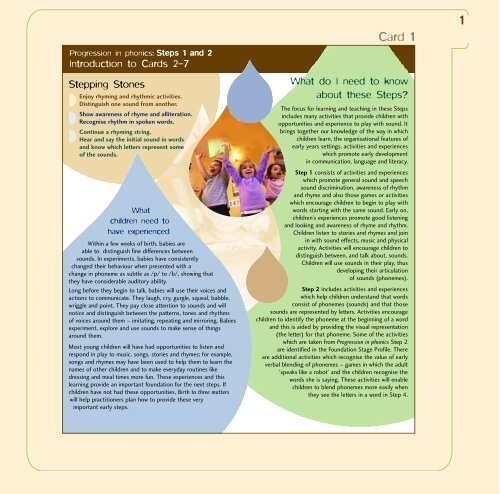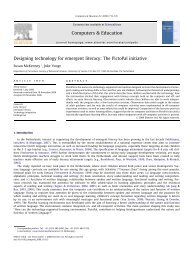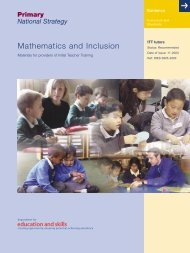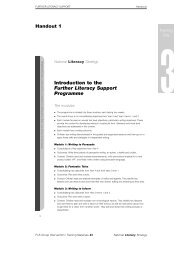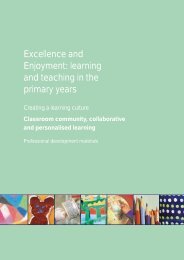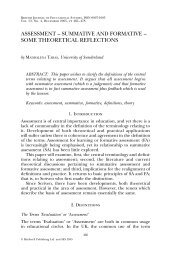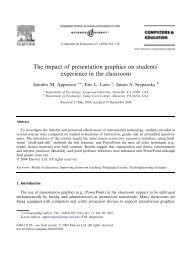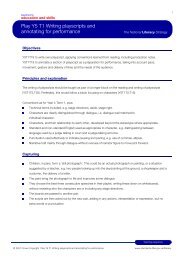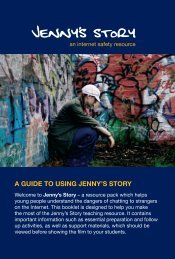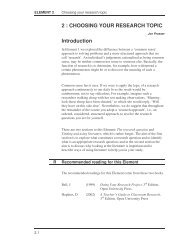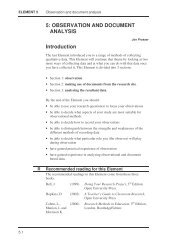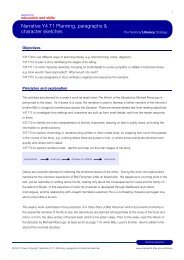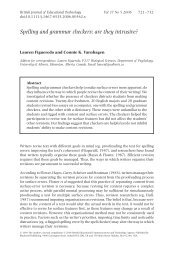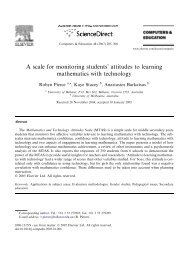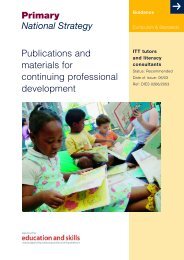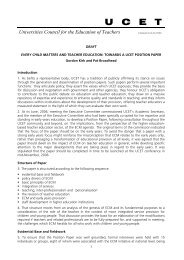A supplement to progression in phonics (cards) 1-3 - PGCE
A supplement to progression in phonics (cards) 1-3 - PGCE
A supplement to progression in phonics (cards) 1-3 - PGCE
Create successful ePaper yourself
Turn your PDF publications into a flip-book with our unique Google optimized e-Paper software.
Progression <strong>in</strong> <strong>phonics</strong>: Steps 1 and 2<br />
Introduction <strong>to</strong> Cards 2–7<br />
Stepp<strong>in</strong>g S<strong>to</strong>nes<br />
◗<br />
◗<br />
◗<br />
Enjoy rhym<strong>in</strong>g and rhythmic activities.<br />
Dist<strong>in</strong>guish one sound from another.<br />
Show awareness of rhyme and alliteration.<br />
Recognise rhythm <strong>in</strong> spoken words.<br />
Cont<strong>in</strong>ue a rhym<strong>in</strong>g str<strong>in</strong>g.<br />
Hear and say the <strong>in</strong>itial sound <strong>in</strong> words<br />
and know which letters represent some<br />
of the sounds.<br />
What<br />
children need <strong>to</strong><br />
have experienced<br />
With<strong>in</strong> a few weeks of birth, babies are<br />
able <strong>to</strong> dist<strong>in</strong>guish f<strong>in</strong>e differences between<br />
sounds. In experiments, babies have consistently<br />
changed their behaviour when presented with a<br />
change <strong>in</strong> phoneme as subtle as /p/ <strong>to</strong> /b/, show<strong>in</strong>g that<br />
they have considerable audi<strong>to</strong>ry ability.<br />
Long before they beg<strong>in</strong> <strong>to</strong> talk, babies will use their voices and<br />
actions <strong>to</strong> communicate. They laugh, cry, gurgle, squeal, babble,<br />
wriggle and po<strong>in</strong>t. They pay close attention <strong>to</strong> sounds and will<br />
notice and dist<strong>in</strong>guish between the patterns, <strong>to</strong>nes and rhythms<br />
of voices around them – imitat<strong>in</strong>g, repeat<strong>in</strong>g and mirror<strong>in</strong>g. Babies<br />
experiment, explore and use sounds <strong>to</strong> make sense of th<strong>in</strong>gs<br />
around them.<br />
Most young children will have had opportunities <strong>to</strong> listen and<br />
respond <strong>in</strong> play <strong>to</strong> music, songs, s<strong>to</strong>ries and rhymes; for example,<br />
songs and rhymes may have been used <strong>to</strong> help them <strong>to</strong> learn the<br />
names of other children and <strong>to</strong> make everyday rout<strong>in</strong>es like<br />
dress<strong>in</strong>g and meal times more fun. These experiences and this<br />
learn<strong>in</strong>g provide an important foundation for the next steps. If<br />
children have not had these opportunities, Birth <strong>to</strong> three matters<br />
will help practitioners plan how <strong>to</strong> provide these very<br />
important early steps.<br />
Card 1<br />
What do I need <strong>to</strong> know<br />
about these Steps?<br />
The focus for learn<strong>in</strong>g and teach<strong>in</strong>g <strong>in</strong> these Steps<br />
<strong>in</strong>cludes many activities that provide children with<br />
opportunities and experience <strong>to</strong> play with sound. It<br />
br<strong>in</strong>gs <strong>to</strong>gether our knowledge of the way <strong>in</strong> which<br />
children learn, the organisational features of<br />
early years sett<strong>in</strong>gs, activities and experiences<br />
which promote early development<br />
<strong>in</strong> communication, language and literacy.<br />
Step 1 consists of activities and experiences<br />
which promote general sound and speech<br />
sound discrim<strong>in</strong>ation, awareness of rhythm<br />
and rhyme and also those games or activities<br />
which encourage children <strong>to</strong> beg<strong>in</strong> <strong>to</strong> play with<br />
words start<strong>in</strong>g with the same sound. Early on,<br />
children’s experiences promote good listen<strong>in</strong>g<br />
and look<strong>in</strong>g and awareness of rhyme and rhythm.<br />
Children listen <strong>to</strong> s<strong>to</strong>ries and rhymes and jo<strong>in</strong><br />
<strong>in</strong> with sound effects, music and physical<br />
activity. Activities will encourage children <strong>to</strong><br />
dist<strong>in</strong>guish between, and talk about, sounds.<br />
Children will use sounds <strong>in</strong> their play, thus<br />
develop<strong>in</strong>g their articulation<br />
of sounds (phonemes).<br />
Step 2 <strong>in</strong>cludes activities and experiences<br />
which help children understand that words<br />
consist of phonemes (sounds) and that those<br />
sounds are represented by letters. Activities encourage<br />
children <strong>to</strong> identify the phoneme at the beg<strong>in</strong>n<strong>in</strong>g of a word<br />
and this is aided by provid<strong>in</strong>g the visual representation<br />
(the letter) for that phoneme. Some of the activities<br />
which are taken from Progression <strong>in</strong> <strong>phonics</strong> Step 2<br />
are identified <strong>in</strong> the Foundation Stage Profile. There<br />
are additional activities which recognise the value of early<br />
verbal blend<strong>in</strong>g of phonemes – games <strong>in</strong> which the adult<br />
‘speaks like a robot’ and the children recognise the<br />
words she is say<strong>in</strong>g. These activities will enable<br />
children <strong>to</strong> blend phonemes more easily when<br />
they see the letters <strong>in</strong> a word <strong>in</strong> Step 4.<br />
1
Card 1<br />
Progression <strong>in</strong> <strong>phonics</strong>: Steps 1 and 2<br />
Introduction <strong>to</strong> Cards 2–7<br />
Resources<br />
Step 1<br />
• a variety of simple <strong>in</strong>struments<br />
• materials <strong>to</strong> make ‘sound makers’ – conta<strong>in</strong>ers,<br />
but<strong>to</strong>ns, beads, seeds, rice, etc<br />
• tape recorder, tapes, microphone<br />
• s<strong>to</strong>ries rich <strong>in</strong> sound effect possibilities<br />
• a bank of rhymes and songs for shar<strong>in</strong>g – some on<br />
cassettes/CDs<br />
• collections of objects beg<strong>in</strong>n<strong>in</strong>g with the same<br />
phoneme<br />
Step 2<br />
• pebble<br />
• puppets or soft <strong>to</strong>ys and a box <strong>to</strong> hide one <strong>in</strong><br />
• ball of str<strong>in</strong>g<br />
• examples of patterned text<br />
• rhym<strong>in</strong>g objects/pictures<br />
• examples of sound sentences<br />
• tray letters – magnetic/card/wooden<br />
• magnetic/metal board or tray<br />
• collections of objects beg<strong>in</strong>n<strong>in</strong>g with<br />
the same phoneme<br />
• three hoops<br />
• shopp<strong>in</strong>g bag/basket<br />
Assess<strong>in</strong>g<br />
children’s development<br />
The examples of child-<strong>in</strong>itiated learn<strong>in</strong>g, play and other<br />
activities on these <strong>cards</strong> provide opportunities for <strong>in</strong>formed<br />
observation. Such observations are the basis for assessments<br />
for learn<strong>in</strong>g for <strong>in</strong>dividual children from which next steps <strong>in</strong><br />
learn<strong>in</strong>g and teach<strong>in</strong>g can be planned. They also help ensure<br />
identification of special educational needs.<br />
The phonemic concepts, skills and knowledge for earlier<br />
foundation stage are conta<strong>in</strong>ed <strong>in</strong> the Curriculum guidance for<br />
the Foundation Stage ‘Stepp<strong>in</strong>g s<strong>to</strong>nes’. Some examples of what<br />
children are able <strong>to</strong> do at each step are reproduced below from<br />
the Curriculum guidance.<br />
The examples of child-<strong>in</strong>itiated learn<strong>in</strong>g and play and the<br />
other activities and opportunities illustrated <strong>in</strong> these <strong>cards</strong><br />
are all related specifically <strong>to</strong> the development of children’s<br />
phonemic concepts, skills and knowledge which contribute<br />
<strong>to</strong> their ability <strong>to</strong> read and write. Some of this development<br />
takes place <strong>in</strong>cidentally <strong>in</strong> the course of play focused<br />
on other areas of learn<strong>in</strong>g; some, such as rhym<strong>in</strong>g and<br />
alliteration, is designed specifically as language play<br />
and some of this may stem from rhymes <strong>in</strong> books.<br />
In addition <strong>to</strong> phonemic development, early years<br />
practitioners, parents and carers <strong>in</strong>spire a knowledge and<br />
love of books, s<strong>to</strong>ries, poems and songs through read<strong>in</strong>g<br />
<strong>to</strong> children – role-play, s<strong>in</strong>g<strong>in</strong>g, s<strong>to</strong>ry-tell<strong>in</strong>g, improvis<strong>in</strong>g.<br />
These <strong>cards</strong> do not conta<strong>in</strong> examples of these sorts<br />
of experiences, other than <strong>in</strong>cidentally. These <strong>cards</strong> are<br />
specifically focused on phonemic development.<br />
Taken from Curriculum guidance for the Foundation Stage (QCA/00/587)
Progression <strong>in</strong> <strong>phonics</strong>: Step 1<br />
Enjoy rhym<strong>in</strong>g and rhythmic activities<br />
Examples of child-<strong>in</strong>itiated<br />
learn<strong>in</strong>g and play<br />
Jack and Kim enjoyed sett<strong>in</strong>g up a listen<strong>in</strong>g<br />
area on the carpet. They collected a tape<br />
recorder, a collection of tapes and some<br />
cushions – ‘<strong>to</strong> make it cosy’.<br />
They enjoyed choos<strong>in</strong>g, listen<strong>in</strong>g <strong>to</strong><br />
and jo<strong>in</strong><strong>in</strong>g <strong>in</strong> with the familiar songs<br />
and rhymes. The practitioner<br />
jo<strong>in</strong>ed them and suggested<br />
add<strong>in</strong>g some soft <strong>to</strong>ys as an<br />
audience <strong>to</strong> enjoy the music<br />
and songs. The children began<br />
<strong>to</strong> share with their audience<br />
some of the actions. With<br />
the adult’s help the children<br />
recorded their songs.<br />
Stepp<strong>in</strong>g<br />
S<strong>to</strong>ne<br />
The outdoor area<br />
<strong>in</strong>cluded a board with<br />
pho<strong>to</strong>graphs of children<br />
play<strong>in</strong>g familiar games.<br />
A group of children used this as<br />
a memory jogger. They chose the<br />
game of ‘The farmer’s <strong>in</strong> his dell’.<br />
The activity was extended by Mary,<br />
a practitioner, who helped them<br />
develop a system of record<strong>in</strong>g<br />
which games they had played<br />
dur<strong>in</strong>g the session.<br />
These children are play<strong>in</strong>g ‘Here<br />
we go round the mulberry bush’.<br />
We also s<strong>in</strong>g it <strong>to</strong> accompany<br />
rout<strong>in</strong>e activities. ‘This is the way<br />
we… tidy up/ have our dr<strong>in</strong>k/ put<br />
on our coats/eat our lunch…<br />
on a sunny, sunny<br />
Monday/ra<strong>in</strong>y, ra<strong>in</strong>y<br />
Tuesday’, etc.<br />
These children are<br />
hav<strong>in</strong>g a great time outside<br />
play<strong>in</strong>g games which<br />
<strong>in</strong>volve rhymes and<br />
rhythmic activities.<br />
They are play<strong>in</strong>g<br />
‘R<strong>in</strong>g o’ roses’<br />
and enjoy<strong>in</strong>g<br />
us<strong>in</strong>g lots of<br />
space and<br />
s<strong>in</strong>g<strong>in</strong>g at<br />
the <strong>to</strong>ps of<br />
their voices.<br />
Card 2<br />
Other activities<br />
and opportunities<br />
2<br />
‘Rhyme-time’<br />
haversacks had been put<br />
<strong>to</strong>gether by some practitioners<br />
and shared with the children <strong>in</strong> group<br />
time. They consisted of the rhyme on card,<br />
a tape, a related non-fiction book and some<br />
artefacts that children could use <strong>to</strong> help recreate<br />
the rhyme. The children often <strong>to</strong>ok them home<br />
<strong>to</strong> share with their parents. Two children chose<br />
<strong>to</strong> play with the haversacks. They acted out the<br />
rhymes and enjoyed mak<strong>in</strong>g some extra th<strong>in</strong>gs<br />
<strong>to</strong> go <strong>in</strong> the bags. They made more spiders<br />
<strong>to</strong> go <strong>in</strong> the Incey W<strong>in</strong>cey Spider bag<br />
and a little book <strong>in</strong> which children<br />
could draw any spiders<br />
they found.<br />
Some African<br />
musicians visited and the<br />
children enjoyed clapp<strong>in</strong>g, play<strong>in</strong>g<br />
<strong>in</strong>struments and danc<strong>in</strong>g along <strong>to</strong> the<br />
strong rhythmic beat of the drums.<br />
These children are enjoy<strong>in</strong>g us<strong>in</strong>g their<br />
<strong>in</strong>door space <strong>to</strong> s<strong>in</strong>g and dance<br />
<strong>to</strong> some songs that they know. Parents<br />
have shared some of the s<strong>in</strong>g<strong>in</strong>g games they<br />
remembered from their childhood.<br />
This has given the children an opportunity<br />
<strong>to</strong> share rhymes from many<br />
different cultures.
Card 2<br />
Progression <strong>in</strong> <strong>phonics</strong>: Step 1<br />
Enjoy rhym<strong>in</strong>g and rhythmic activities<br />
Suggested activities<br />
Jo<strong>in</strong> <strong>in</strong><br />
In large group time, s<strong>in</strong>g some of your favourite songs and<br />
rhymes <strong>to</strong> the children. As the songs and rhymes become more<br />
familiar, children will beg<strong>in</strong> <strong>to</strong> jo<strong>in</strong> <strong>in</strong> with the parts they know.<br />
S<strong>in</strong>g a l<strong>in</strong>e and encourage children <strong>to</strong> repeat it as an echo. Miss<br />
out the ends of some of the l<strong>in</strong>es and ask the children <strong>to</strong> s<strong>in</strong>g<br />
the miss<strong>in</strong>g part.<br />
‘We often try <strong>to</strong> l<strong>in</strong>k the choice of songs <strong>to</strong> our focus.<br />
This time we have shared lots of animal songs because<br />
the animal man has just visited. He brought a selection<br />
of animals for us <strong>to</strong> look at.’<br />
Let’s dance<br />
S<strong>in</strong>g songs that have dances <strong>to</strong> them so that children can move<br />
their whole bodies <strong>to</strong> the beat, e.g.<br />
• In and out the dusty bluebells<br />
• Here we go round the mulberry bush<br />
• The big ship sails on the alley alley o<br />
• Oranges and lemons<br />
• R<strong>in</strong>g a r<strong>in</strong>g o’ roses<br />
‘Children sometimes s<strong>in</strong>g and dance when they choose <strong>to</strong> play<br />
outside. Their play is resourced with <strong>in</strong>struments, and with<br />
fabrics which they sway and <strong>in</strong>clude <strong>in</strong> their dances.’<br />
Mirror me<br />
Dur<strong>in</strong>g planned physical activity s<strong>in</strong>g or chant rhymes and<br />
encourage the children <strong>to</strong> move <strong>in</strong> an appropriate way, e.g.<br />
• The grand old Duke of York<br />
• Tw<strong>in</strong>kle tw<strong>in</strong>kle little star<br />
• If you’re happy and you know it<br />
• I’m a little teapot<br />
‘As the children dance along <strong>to</strong> the rhymes I often dance<br />
alongside and <strong>in</strong>troduce new movements which encourage<br />
children <strong>to</strong> use different parts of their bodies.’<br />
Action rhymes<br />
Make up some actions <strong>to</strong> songs and<br />
encourage the children <strong>to</strong> do the actions <strong>in</strong> time<br />
<strong>to</strong> the music, e.g.<br />
• Head, shoulders, knees and <strong>to</strong>es<br />
• Knock at the door<br />
• Incey w<strong>in</strong>cey spider<br />
• Jelly on the plate<br />
‘When children know the songs and the actions we encourage<br />
them <strong>to</strong> s<strong>in</strong>g parts of the song <strong>in</strong> their heads and just<br />
do the actions. They really have <strong>to</strong> concentrate.’<br />
Let’s perform<br />
Record or video the children when they are s<strong>in</strong>g<strong>in</strong>g some of their<br />
favourite songs and rhymes. Include some rhymes from our diverse<br />
cultural heritage, e.g.<br />
• Chanda Mama (Uncle Moon, Urdu/H<strong>in</strong>di)<br />
• Ayk do tali bejao (Gujarati)<br />
The children will enjoy play<strong>in</strong>g the tapes back and jo<strong>in</strong><strong>in</strong>g <strong>in</strong>.<br />
‘We played the video <strong>to</strong> the parents and carers at the end of<br />
the session and they said that they enjoyed see<strong>in</strong>g their children<br />
s<strong>in</strong>g<strong>in</strong>g along with their friends. It was a good opportunity <strong>to</strong> build<br />
up a reper<strong>to</strong>ire of songs that adults and children can share when<br />
at home – the tape was often out on loan.’<br />
Count<strong>in</strong>g rhymes<br />
S<strong>in</strong>g count<strong>in</strong>g rhymes with the children. Gradually build up<br />
a reper<strong>to</strong>ire of count<strong>in</strong>g rhymes that the children become familiar<br />
with. They will enjoy jo<strong>in</strong><strong>in</strong>g <strong>in</strong> with the parts that they know, e.g.<br />
• One, two, buckle my shoe<br />
• Ten green bottles<br />
• This old man<br />
• Ten fat sausages<br />
• Ten <strong>in</strong> a bed<br />
• Five currant buns<br />
‘I try <strong>to</strong> resource some of the count<strong>in</strong>g rhymes and use the<br />
resources <strong>to</strong> model the maths <strong>in</strong>volved. I’ve made the five currant<br />
buns and the ten green bottles available for children <strong>to</strong> choose<br />
<strong>in</strong> child-<strong>in</strong>itiated activities.’
Progression <strong>in</strong> <strong>phonics</strong>: Step 1<br />
Dist<strong>in</strong>guish one sound from another<br />
Examples of child-<strong>in</strong>itiated<br />
learn<strong>in</strong>g and play<br />
San<strong>to</strong>k and Lewis decided <strong>to</strong> take the writ<strong>in</strong>g<br />
materials outside and planned <strong>to</strong> make their<br />
own outdoor ‘listen<strong>in</strong>g list’. Listen<strong>in</strong>g lists<br />
had been an adult-led activity earlier<br />
<strong>in</strong> the week. They drew pictures<br />
<strong>to</strong> rem<strong>in</strong>d themselves of all the th<strong>in</strong>gs<br />
they could hear. This was developed<br />
when a practitioner <strong>in</strong>troduced a tape<br />
recorder <strong>to</strong> help the children record<br />
some of the sounds.<br />
Practitioners had set up an<br />
‘<strong>in</strong>strument fac<strong>to</strong>ry’ with lots of<br />
materials <strong>to</strong> make sound makers.<br />
The children set about mak<strong>in</strong>g enough<br />
<strong>in</strong>struments for a band! They gathered<br />
other materials from around the sett<strong>in</strong>g.<br />
The play was extended by a practitioner,<br />
pretend<strong>in</strong>g <strong>to</strong> be manager, who<br />
<strong>in</strong>troduced the idea of quality control –<br />
‘The <strong>in</strong>struments need <strong>to</strong> be tested<br />
<strong>to</strong> make sure that they can<br />
make at least three different<br />
sounds.’ They all passed the test.<br />
The band sounded great.<br />
When us<strong>in</strong>g<br />
the computer<br />
the children learned<br />
that the different<br />
sounds made by the<br />
program mean different<br />
th<strong>in</strong>gs. Sometimes they are<br />
congratulated on their<br />
success; sometimes the<br />
sound <strong>in</strong>dicates they<br />
need <strong>to</strong> try aga<strong>in</strong>.<br />
Stepp<strong>in</strong>g<br />
S<strong>to</strong>ne<br />
A ‘record<strong>in</strong>g<br />
studio’ had been<br />
set up with a tape<br />
recorder, microphone and<br />
sound makers. It had been used<br />
as an adult-led session earlier <strong>in</strong> the<br />
week. The children returned <strong>to</strong> the<br />
resources and made, recorded and played<br />
back sounds us<strong>in</strong>g their voices and<br />
<strong>in</strong>struments. This turned <strong>in</strong><strong>to</strong> a game<br />
and they <strong>in</strong>vited friends <strong>to</strong> listen<br />
<strong>to</strong> the tape and guess how they’d made<br />
the sound. They collected wigs and<br />
clothes from the role-play area<br />
and pretended <strong>to</strong> be pop stars.<br />
In the home<br />
corner one of the children<br />
talked about the r<strong>in</strong>g <strong>to</strong>ne<br />
of her mother’s mobile phone.<br />
The practitioner got her<br />
phone and they explored<br />
the choice of sounds available<br />
and those sounds<br />
they liked.<br />
Children set up a small<br />
world role-play of<br />
Thomas the Tank<br />
Eng<strong>in</strong>e. They made the<br />
sound of Thomas<br />
chugg<strong>in</strong>g along the track<br />
(chchch), slow<strong>in</strong>g down<br />
as he comes <strong>in</strong><strong>to</strong> the<br />
station (shshsh) and the<br />
big eng<strong>in</strong>es whizz<strong>in</strong>g past<br />
whistl<strong>in</strong>g (ooooooo).<br />
These children are <strong>in</strong> the book<br />
area enjoy<strong>in</strong>g read<strong>in</strong>g s<strong>to</strong>ries<br />
<strong>to</strong>gether and add<strong>in</strong>g sound<br />
effects. They had already<br />
listened <strong>to</strong> the s<strong>to</strong>ry<br />
‘Farmer Duck’ with<br />
a practitioner, and<br />
now were play<strong>in</strong>g<br />
Charlie<br />
was <strong>in</strong> the<br />
garden and po<strong>in</strong>ted<br />
out that the blackbird<br />
sounded like she was tell<strong>in</strong>g<br />
them off when the children all<br />
came out and disturbed her<br />
digg<strong>in</strong>g for someth<strong>in</strong>g <strong>in</strong> the<br />
vegetable bed. The practitioner<br />
remembered a CD with record<strong>in</strong>gs<br />
of birdsong and played the<br />
different sounds made by<br />
blackbirds <strong>to</strong> Charlie and<br />
his friends.<br />
<strong>in</strong>dependently,<br />
mak<strong>in</strong>g sounds<br />
of the animals.<br />
They were<br />
add<strong>in</strong>g more<br />
animals <strong>to</strong> the s<strong>to</strong>ry<br />
<strong>in</strong>clud<strong>in</strong>g a donkey ‘Eeaw’<br />
and <strong>in</strong>sects such<br />
as bees and flies ‘zzzzz’ and ‘mmm’.<br />
Card 3<br />
Other activities<br />
and opportunities<br />
Children play <strong>in</strong> the water tray which has been<br />
resourced with materials <strong>to</strong> create different<br />
sounds – water<strong>in</strong>g cans, jugs, paddles, sieves,<br />
pumps, etc. They enjoyed the challenge set<br />
by the practitioner of mak<strong>in</strong>g as many<br />
different sounds as they could. They added<br />
their own resources <strong>to</strong> make even<br />
more sounds.<br />
These children are play<strong>in</strong>g a game with<br />
<strong>in</strong>struments. The activity has been set out with<br />
three different types of <strong>in</strong>strument, two of each<br />
type and a screen. One child is the ‘sound maker’<br />
beh<strong>in</strong>d the screen and makes a sound with one<br />
of his three <strong>in</strong>struments. The other child<br />
is the ‘sound detective’ on the other<br />
side of the screen with his three<br />
<strong>in</strong>struments. He needs<br />
<strong>to</strong> guess which type of<br />
<strong>in</strong>strument has made<br />
the sound. They use<br />
pho<strong>to</strong>graphs and<br />
labels <strong>to</strong> replace<br />
the <strong>in</strong>struments<br />
<strong>in</strong> the music area<br />
when they<br />
have f<strong>in</strong>ished.<br />
3
Card 3<br />
Progression <strong>in</strong> <strong>phonics</strong>: Step 1<br />
Dist<strong>in</strong>guish one sound from another<br />
Suggested activities<br />
Listen<strong>in</strong>g lists/walks<br />
This is a listen<strong>in</strong>g activity that can take place <strong>in</strong> lots of different areas<br />
<strong>in</strong>side and outside the sett<strong>in</strong>g – <strong>in</strong> the kitchen, on visits, <strong>in</strong> the<br />
garden, etc.<br />
Invite the children <strong>to</strong> show you how good they are at listen<strong>in</strong>g and<br />
talk about why listen<strong>in</strong>g is important.<br />
When you listen it helps you <strong>to</strong> hear birds s<strong>in</strong>g, what your friends<br />
are say<strong>in</strong>g and <strong>to</strong> remember th<strong>in</strong>gs for next time. It helps you <strong>to</strong><br />
enjoy music and <strong>to</strong> know who is talk<strong>in</strong>g when you answer the phone.<br />
It helps you <strong>to</strong> understand friends who are just learn<strong>in</strong>g English.<br />
Rem<strong>in</strong>d the children about the th<strong>in</strong>gs that good listeners do (e.g.<br />
keep quite still, keep quiet, have eyes and ears ready). Then<br />
encourage them <strong>to</strong> listen <strong>to</strong> the sounds around them. Talk about the<br />
different sounds they can hear. Make a list of th<strong>in</strong>gs heard as words,<br />
simple pictures or tape record<strong>in</strong>gs. Talk about why lists are useful<br />
<strong>to</strong> help us remember th<strong>in</strong>gs.<br />
‘After we had been on our walk, we had fun try<strong>in</strong>g <strong>to</strong><br />
recreate the sounds with our voices. Gary made a really good<br />
mo<strong>to</strong>rbike sound.’<br />
Guess who<br />
Rem<strong>in</strong>d children about be<strong>in</strong>g good listeners, then play a hid<strong>in</strong>g game<br />
where children use their voices <strong>to</strong> say an agreed sound or phrase,<br />
e.g. ‘Good morn<strong>in</strong>g everyone.’<br />
Can they guess whose voice it is?<br />
Talk <strong>to</strong>gether about what clues they used <strong>to</strong> help them guess.<br />
‘We found this activity was best played <strong>in</strong> a small group so that<br />
everyone had a go, they didn’t have <strong>to</strong> wait <strong>to</strong>o long for their turn<br />
and they didn’t have <strong>to</strong>o many possibilities <strong>to</strong> choose from.’<br />
Guess the sound<br />
Rem<strong>in</strong>d the children about be<strong>in</strong>g good listeners. Organise several<br />
different sound sources beh<strong>in</strong>d a screen, e.g. water be<strong>in</strong>g poured,<br />
splashed or shaken <strong>in</strong> a bottle.<br />
Ask the children <strong>to</strong> guess what they th<strong>in</strong>k is mak<strong>in</strong>g the sound. Talk<br />
about the sounds, e.g. loud, quiet, long or short.<br />
You could use musical <strong>in</strong>struments <strong>in</strong>stead of found sound sources.<br />
‘We used record<strong>in</strong>gs we had made on one of our listen<strong>in</strong>g walks<br />
(see listen<strong>in</strong>g lists) <strong>to</strong> see if children could remember and<br />
recognise the different sounds.’<br />
Let me hear<br />
your …voice<br />
Encourage the children <strong>to</strong> experiment with<br />
their voices by s<strong>in</strong>g<strong>in</strong>g:<br />
‘Let me hear your s<strong>in</strong>g<strong>in</strong>g voice – hello hello’<br />
The children repeat ‘hello hello’ with the voice that has<br />
been requested.<br />
Then try:<br />
Let me hear your <strong>in</strong>side/outside/whisper<strong>in</strong>g/shout<strong>in</strong>g/<br />
growl<strong>in</strong>g voice, etc.<br />
‘We talked about how useful and important it was <strong>to</strong> use different<br />
voices at different times and how we can sometimes tell what<br />
sort of mood people are <strong>in</strong> by listen<strong>in</strong>g <strong>to</strong> their voices and<br />
look<strong>in</strong>g at their faces. We had fun try<strong>in</strong>g out a few <strong>to</strong>gether –<br />
angry sad, shy, etc.’<br />
Give me a sound<br />
Encourage the children <strong>to</strong> experiment with different sounds that they<br />
can make with their voices.<br />
Can they make their voice …?<br />
• go down a slide whee<br />
• buzz like a bee<br />
zzzzz<br />
• hiss like a snake ssssss<br />
• relax <strong>in</strong><strong>to</strong> a chair aaah<br />
• sound surprised ooo<br />
Encourage children <strong>to</strong> come up with other ideas.<br />
Show them how they can use their voices <strong>to</strong> put sound effects <strong>to</strong> a<br />
s<strong>to</strong>ry. Most children’s s<strong>to</strong>ries lend themselves <strong>to</strong> sound effects, e.g.<br />
Mr Gumpy’s out<strong>in</strong>g – animal noises, doors creak<strong>in</strong>g and bang<strong>in</strong>g, etc.<br />
‘Children enjoyed putt<strong>in</strong>g the sound effects <strong>to</strong> the s<strong>to</strong>ry “A Dark<br />
Dark Tale”, especially the creak<strong>in</strong>g sounds go<strong>in</strong>g up the stairs.’<br />
Me then you<br />
In small group time, practise clapp<strong>in</strong>g loudly, softly, quickly, and slowly.<br />
Introduce the idea of clapp<strong>in</strong>g/tapp<strong>in</strong>g patterns, e.g. three short<br />
sounds followed by two short sounds. Talk about the pattern as you<br />
are clapp<strong>in</strong>g/ tapp<strong>in</strong>g it. Encourage the children <strong>to</strong> repeat or echo<br />
the pattern.<br />
‘I often use <strong>in</strong>struments for this activity. I use a tambour<strong>in</strong>e and<br />
another tambour<strong>in</strong>e is passed around the circle for each child <strong>in</strong> turn<br />
<strong>to</strong> try <strong>to</strong> echo my pattern. We talk about the patterns <strong>to</strong> re<strong>in</strong>force<br />
the language.’


